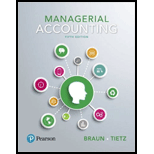
Concept explainers
Comprehensive summary problem (Learning Objectives 2 & 3)
Birdfeeders Unlimited makes backyard birdfeeders. The company sells the birdfeeders to home improvement stores for $15 per birdfeeder. Each birdfeeder requires 1.5 board feet of wood, which the company obtains at a cost of $4 per board foot. The company would like to maintain an ending stock of wood equal to 10% of the next month’s production requirements. The company would also like to maintain an ending stock of finished birdfeeders equal to 20% of the next month’s sales.
Sales data for the company is as follows:
| Units | |
| October actual sales (prior year) | 92.000 |
| November actual sales (prior year) | 85.000 |
| December actual sales (prior year) | 78.000 |
| January projected sales | 80.000 |
| February projected sales | 90.000 |
| March projected sales | 95.000 |
| April projected sales | 105,000 |
In any given month, 20% of the total sales are cash sales, while the remainder are credit sales. The company’s collection history indicates that 80% of credit sales is collected in the month after the sale, 10% is collected two months after the sale, 6% is collected three months after the sale, and the remaining 4% is never collected.
Assume that the total cost of direct materials purchases in December was $550,000. The company pays 45% of its direct materials purchases in the month of purchase and pays the remaining 55% in the month after purchase.
Requirements
Prepare the following budgets for the first three months of the year, as well as a summary budget for the quarter:
- 1. Prepare the sales budget, including a separate section that details the type of sales made (cash versus credit).
- 2. Prepare the production budget.
- 3. Prepare the direct materials purchases budget. Assume the company needs 120,000 board feet of wood for production in April.
- 4. Prepare the cash collections budget for January, February, and March, as well as a summary for the first quarter.
- 5. Prepare the
cash payments budget for direct materials purchases for the months of January, February, and March, as well as a summary for the first quarter.
Want to see the full answer?
Check out a sample textbook solution
Chapter 9 Solutions
Managerial Accounting, Student Value Edition Plus MyLab Accounting with Pearson eText -- Access Card Package (5th Edition)
- Please explain the solution to this general accounting problem with accurate principles.arrow_forwardKindly help me with this General accounting questions not use chart gpt please fast given solutionarrow_forwardI am searching for the correct answer to this Financial accounting problem with proper accounting rules.arrow_forward
- I am looking for the correct answer to this Financial accounting question with appropriate explanations.arrow_forwardEcho Tone Technologies reports annual sales of $90,000, and it expects sales to increase to $135,000 next year. The company has a degree of operating leverage (DOL) of 4.2. By what percentage should net income increase? A. 70% B. 189% C. 150% D. 210%arrow_forwardPlease provide the solution to this general accounting question using proper accounting principles.arrow_forward
- No chatgpt Which account will appear in the post-closing trial balance?A. Rent ExpenseB. Sales RevenueC. DividendsD. Capitalarrow_forwardI need help with this financial accounting question using the proper accounting approach.arrow_forwardI need help Which account will appear in the post-closing trial balance?A. Rent ExpenseB. Sales RevenueC. DividendsD. Capitalarrow_forward
 Managerial Accounting: The Cornerstone of Busines...AccountingISBN:9781337115773Author:Maryanne M. Mowen, Don R. Hansen, Dan L. HeitgerPublisher:Cengage Learning
Managerial Accounting: The Cornerstone of Busines...AccountingISBN:9781337115773Author:Maryanne M. Mowen, Don R. Hansen, Dan L. HeitgerPublisher:Cengage Learning
